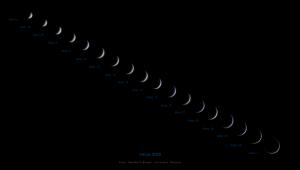Celebration of Space - October 29, 2021
Of all the awesome lore, activities, and culture surrounding Halloween, it’s worth noting that October 31st is also an astronomical holiday. One of the four Cross-Quarter days of the year, Halloween marks the approximate midpoint between the Autumnal Equinox and the Winter Solstice. Cross-quarter days are the days that fall in between the Equinoxes and Solstices. The first cross-quarter day of the year is Groundhog Day, the second is May Day, the third is Lammas in August, and the final is Halloween. While you’re out trick-r-treating or just getting your spook on at home, take note that we are halfway through autumn in the Northern Hemisphere.
On Thursday, November 4, 2021, Earth reaches the point in our orbit where Uranus, the seventh planet from the Sun, is aligned on the opposite side of Earth than the Sun. We call this the Opposition of Uranus, and places Uranus at its closest point to us for our year, and into best viewing. Even though Uranus is the closest to us for the year, it still resides at a massive 1.74 billion miles distant! At that distance it takes light 2.6 hours to reach us. Considering that Uranus is quite large, coming in at the third largest planet in the Solar System, Uranus is just at the limit of naked eye visibility at Frosty Drew Observatory. But that doesn’t mean you will see it naked eye. Being at the limit, every star around it will outshine it. Now that the new PlaneWave telescope is installed in Frosty Drew Observatory, the views of the outer planets will be so much better. So make plans to get out in the coming weeks for a view of Uranus in the new 24 inch telescope.
Since the start of the summer season, Venus has been rising higher and higher in the western sky after sunset, as well as growing brighter. Venus reaches Maximum Eastern Elongation today, October 29, 2021, which is when Venus reaches the point in its orbit when the tangential angle, when viewed from Earth, forms a right angle with the Sun. Think of a triangle comprised of a straight line starting at Earth and ending at an inner planet, then another line from the inner planet (inferior) to the Sun, and a third line extending from the Sun to Earth. When the line from Earth to the inner planet and the line from the inner planet to the Sun form a right angle (90°), you have maximum elongation of the inner planet. Consequently, when the line from Earth to an outer (superior) planet and the line from the Sun to Earth form a right angle, you have Quadrature of the outer planet. Eastern elongation means that the inner planet is at maximum elongation while being placed on the eastern side of the Sun in Earth’s sky. Starting today, Venus dropped into its waning crescent phase, and will continue to wane until it reaches Inferior Conjunction on January 8, 2022, which is when Venus arrives in between Earth and the Sun. Though Venus will continue to wane well into a super thin crescent phase, it will continue to increase in apparent brightness because it is moving closer to us with each passing day. If you have a backyard telescope or high power binoculars, step outside each night over the next few months and catch a view of Venus in the southwestern sky after sunset and notice the rate at which it wanes.
On Thursday, October 28, 2021 at 11:35 am ET, a rather large sunspot that has been transiting the southern hemisphere of the Earth-facing side of the Sun, produced a huge X1-class flare. This intense flare resulted in a Coronal Mass Ejection (CME) hurled almost directly towards Earth. Now this is not cause for panic or concern, yeah you may have spotty cable TV, but I wouldn’t expect the regular citizen to have any issues. But what you may get is a chance to catch a view of the Northern Lights. The coming CME is large enough to produce a level 3 geomagnetic storm (G3), which can bring the Aurora Borealis as far south as 50º latitude visibly, and even further south photographically. In Rhode Island, we need a resulting Kp Index of 7 to see them, but G3 storms often produce that level of activity. It looks like the CME will arrive sometime tomorrow, Saturday, October 30th. A good rule of thumb is “never drive south to see the northern lights”. That rule, makes Frosty Drew Observatory a poor choice to view from as we are on the Rhode Island south coast. Depending on where you live, a trip out to Cape Cod, or a trip to the White Mountains of New Hampshire is certainly warranted. If you head out to find the lights, and happen to capture a photo of the Aurora, post it on our Facebook and we’ll share it to our timeline. Good luck!
Have a Happy and Safe Halloween from all the astro-geeks at Frosty Drew Observatory and Science Center in whatever way you celebrate.
- Author:
- Scott MacNeill
- Entry Date:
- Oct 29, 2021
- Published Under:
- Scott MacNeill's Columns




